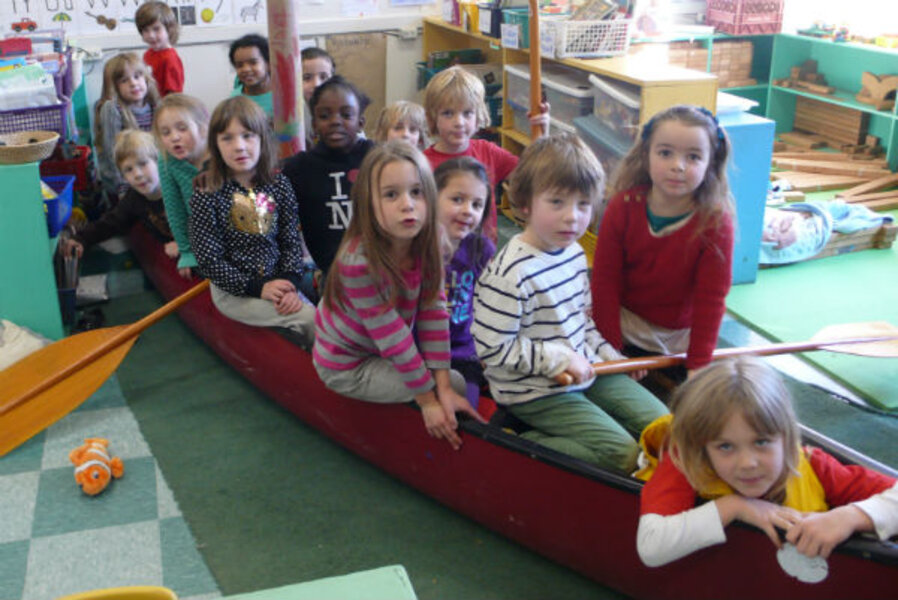Paddling to the sea: the magic of imaginary play
Loading...
There’s a canoe in the Kindergarten, and kindergartners in the canoe. They are paddling the great waters of Lake Superior, heading for the mighty salt sea. They are paddling to the sea, because they have been reading "Paddle to the Sea" by Holling Clancy Holling, the story of the Canadian Indian boy who whittles a wooden canoe one winter and places it in the snow at the headwaters of a watershed that includes the Great Lakes and ends in the sea.
His “Paddle Person” flows from stream to beaver pond to rapids to sawmill, along the freighter-lanes of Lake Superior to steel mills, waterfalls and locks. He ends on the Grand Banks off of Newfoundland and is returned, serendipitously, to his maker. Perhaps you remember this book. Perhaps you too are a Paddle Person.
Is there an educational watershed herein?
Even with a map, it’s hard to comprehend such a journey. But now, for the kindergartners, such a journey is made real through some real props and some imaginative play. They have real paddles, real life preservers, a real red 17-foot canoe (they carried to the classroom from the school swimming pool – a portage!), and they are paddling hard, practicing man-over-board drills, and imagining the water route that will take them to the Great Big Water of the Atlantic Ocean. Paddle Person’s journey has become their journey. Epic imaginative play.
Sure, paddling gets tiresome. And it’s tricky getting everyone’s paddle in and out of the water at precisely the same time, going the same direction. Furthermore, as young Jack told it, “We were in Lake Superior on our way down to Lake Erie. But the wind came up and the current was taking us away. So we needed to make a sail.” As Plato says, “Necessity is the mother of invention.”
Is that the wreck of the Edmund Fitzgerald down there? Time for a mast. Excellent. This will involve sawing a big cardboard tube (a grandparent just happened to bring one by that day), painting it, lashing it to the gunwales, and hoisting sails – teamwork! Now all hands on deck! And this canoe does hold everyone. Wait, what’s a gunwale?
The journey of our intrepid paddlers conjures something akin to Marianne Moore’s hope that the poet-learners among us be capable of presenting “imaginary gardens with real toads in them.” Is paddling a real canoe on an imaginary Lake Superior like a poem? Sure. It is also school done right.
The teachers wrote home about it. “The second the kids paddled into the classroom it became Lake Superior (with a portal to France!),” they reported. “The canoeists faced severe weather, sea monsters and lots of men overboard. Outstanding work is going on and remarkable lessons have been learned all because the canoe rules! Among many other things the canoe has fostered learning in literacy, math and spatial reasoning, team building, resilience, and of course, imaginary play.”
There’s an algorithm to such successful play: equal parts virtual (paddling “Lake Superior”), plus actual (it is, in fact, a real canoe in the classroom). Now stir well, and the product is imaginative play.
Or it’s what the discoverer of another iconic algorithm, Albert Einstein, called “combinatory play.” This, he said, “seems to be the essential feature in productive thought.” Other luminaries chime in on how paddling real canoes across imagined Great Lakes develop into wonderful things. “Connecting the seemingly unconnected is the secret of genius,” says Harvard biologist Stephen Jay Gould. Metaphor, Robert Frost said, is “the one permissible way of saying one thing and meaning another.”
In more recent relevant commentary, this is also “unplugged play,” something the American Academy of Pediatrics (AAP) concludes “is the best way for young children to learn to think creatively, to problem solve, and to develop reasoning, communication, and motor skills.” (See In “The Big Disconnect” by Catherine Steiner-Adair.)
Next door to Kindergarten, downstream in this chain-lake learning system, is the booming economic simulation engine of the fifth and sixth grade classroom. They too are simulating real life, this time in a spontaneous economy that includes banks, manufacturers of all kinds (tea, toffee, clothing and accessories?), service industries, currency, and municipal offices. The kids are handling real life problems in scale model, combinatory scenarios. This is higher-level reasoning, communication, and motor skills. But it’s some of the same skills that any of us are applying to adult careers. We are all down stream from “combinatory play,” if we are fortunate.
This Great Lakes watershed could also be called childhood flowing into adulthood, and beyond. And this canoe of ours holds everyone, paddling together, in the same direction, hopefully. The AAP might be supplying a rudder for us. “In today’s ‘achievement culture,’ the best thing you can do for your young child is to give her a chance to have unstructured play – both with you and independently. Children need this in order to figure out how the world works.”
How the world works? You mean, how Lake Superior is connected to the other great lakes and, eventually, the great Atlantic Ocean? How to navigate; how to manage those blue water currents – and your fellow paddlers. Don’t forget man overboard and lifeboat drills – the world works best when there are well-trained first responders. To say nothing of exploring that portal to France! It’s a big world out there. But it’s a plenty big world right here in the kindergarten classroom. Paddle on.
The Christian Science Monitor has assembled a diverse group of the best family and parenting bloggers out there. Our contributing and guest bloggers are not employed or directed by the Monitor, and the views expressed are the bloggers' own, as is responsibility for the content of their blogs. Todd R. Nelson is Head of School at The School in Rose Valley, Pa.








